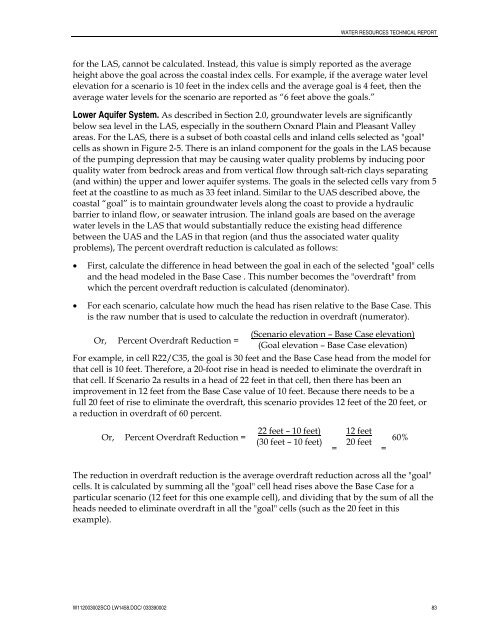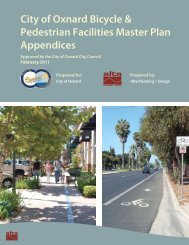WATER RESOURCES TECHNICAL REPORTfor the LAS, cannot be calculated. Instead, this value is simply reported as the averageheight above the goal across the coastal index cells. For example, if the average water levelelevation for a scenario is 10 feet in the index cells and the average goal is 4 feet, then theaverage water levels for the scenario are reported as “6 feet above the goals.”Lower Aquifer System. As described in Section 2.0, groundwater levels are significantlybelow sea level in the LAS, especially in the southern <strong>Oxnard</strong> Plain and Pleasant Valleyareas. For the LAS, there is a subset <strong>of</strong> both coastal cells and inland cells selected as "goal"cells as shown in Figure 2-5. There is an inland component for the goals in the LAS because<strong>of</strong> the pumping depression that may be causing water quality problems by inducing poorquality water from bedrock areas and from vertical flow through salt-rich clays separating(and within) the upper and lower aquifer systems. The goals in the selected cells vary from 5feet at the coastline to as much as 33 feet inland. Similar to the UAS described above, thecoastal “goal” is to maintain groundwater levels along the coast to provide a hydraulicbarrier to inland flow, or seawater intrusion. The inland goals are based on the averagewater levels in the LAS that would substantially reduce the existing head differencebetween the UAS and the LAS in that region (and thus the associated water qualityproblems), The percent overdraft reduction is calculated as follows:• First, calculate the difference in head between the goal in each <strong>of</strong> the selected "goal" cellsand the head modeled in the Base Case . This number becomes the "overdraft" fromwhich the percent overdraft reduction is calculated (denominator).• For each scenario, calculate how much the head has risen relative to the Base Case. Thisis the raw number that is used to calculate the reduction in overdraft (numerator).(Scenario elevation – Base Case elevation)Or, Percent Overdraft Reduction =(Goal elevation – Base Case elevation)For example, in cell R22/C35, the goal is 30 feet and the Base Case head from the model forthat cell is 10 feet. Therefore, a 20-foot rise in head is needed to eliminate the overdraft inthat cell. If Scenario 2a results in a head <strong>of</strong> 22 feet in that cell, then there has been animprovement in 12 feet from the Base Case value <strong>of</strong> 10 feet. Because there needs to be afull 20 feet <strong>of</strong> rise to eliminate the overdraft, this scenario provides 12 feet <strong>of</strong> the 20 feet, ora reduction in overdraft <strong>of</strong> 60 percent.Or, Percent Overdraft Reduction =22 feet – 10 feet)(30 feet – 10 feet)=12 feet20 feet=60%The reduction in overdraft reduction is the average overdraft reduction across all the "goal"cells. It is calculated by summing all the "goal" cell head rises above the Base Case for aparticular scenario (12 feet for this one example cell), and dividing that by the sum <strong>of</strong> all theheads needed to eliminate overdraft in all the "goal" cells (such as the 20 feet in thisexample).W112003002SCO LW1458.DOC/ 033390002 83
WATER RESOURCES TECHNICAL REPORT6.2 ResultsThe simulation results for the end <strong>of</strong> the calibration period, the Base Case, and the Phase 1and Phase 2 scenarios are provided below.6.2.1 End <strong>of</strong> Calibration PeriodThe simulated groundwater elevations at the end <strong>of</strong> the model calibration period, 2000, areprovided in Figure 6-6 and 6-7 for the UAS and LAS, respectively. Overall, the third quarter2000 simulated groundwater elevations are similar to actual fall 2002 data shown inFigures 2-18 and 2-19 for the UAS and LAS, respectively. Variations between these data setsoccur and are due to several factors including: limited number <strong>of</strong> available water levelcontrol points, hand contouring limitations for the 2002 data, and the drier years betweenfrom 2000 and 2002. The third quarter 2000 simulated results indicate the following:• Water levels are 15 to 30 feet above sea level in the UAS along the <strong>Oxnard</strong> Plain coastlineand increase robustly landward to near between 50 to 100 feet above sea level in thecentral to northeastern portion <strong>of</strong> the Forebay area, which is where the UWCDspreading grounds are located.• Water levels are at about sea level in the LAS along the northern <strong>Oxnard</strong> Plain coastline,remain at about sea level landward across most <strong>of</strong> the northern <strong>Oxnard</strong> Plain, and thenincrease to above sea level in the Forebay area.• Water levels are roughly 20 to 30 feet below sea level along the southern <strong>Oxnard</strong> Plaincoastline and decrease landward to a low <strong>of</strong> approximately 70 feet below sea level.6.2.2 Base Case and Phase 1 ScenariosThe simulated third quarter 2020 groundwater elevations for the Base Case and Phase 1scenarios, and the first/third average quarter 2020 water level differences, or changes,between the Base Case and each <strong>of</strong> the Phase 1 scenarios are provided in the followingfigures:• Base Case: Figures 6-8 and 6-9, UAS and LAS, respectively• Scenario 1a: Figures 6-10 and 6-11, UAS and LAS, respectively• Scenario 1b: Figures 6-12 and 6-13, UAS and LAS, respectively• Scenario 1c: Figures 6-14 and 6-15, UAS and LAS, respectivelyHydrographs for the historical and simulated groundwater elevations for each <strong>of</strong> the keyevaluation wells (Figure 6-2) are provided in Figure 6-16 for the Base Case and each <strong>of</strong> thePhase 1 scenarios. The hydrographs are grouped into three areas, one area for each <strong>of</strong> thethree pages <strong>of</strong> hydrographs:• <strong>Oxnard</strong> Forebay Area (page 1 <strong>of</strong> 3)• Northern <strong>Oxnard</strong> Plain Area (page 2 <strong>of</strong> 3)• Southern <strong>Oxnard</strong> Plain Area (page 3 <strong>of</strong> 3)Base CaseThe Base Case resulted in third quarter 2020 groundwater elevations that are lower than thethird quarter 2000 results. This is, in part, because the cumulative from average precipitationW112003002SCO LW1458.DOC/ 033390002 84
- Page 4 and 5:
CONTENTS6.2.2 Base Case and Phase 1
- Page 6 and 7:
CONTENTSFiguresSection 1.0 - Introd
- Page 8 and 9:
AcronymsACPAFYASRAWTFBasin PlanbgsB
- Page 10:
1.0 IntroductionThis Technical Repo
- Page 13 and 14:
WATER RESOURCES TECHNICAL REPORT•
- Page 15 and 16:
SANTA BARBARACOUNTYSanta BarbaraVEN
- Page 17 and 18:
WATER RESOURCES TECHNICAL REPORT2.2
- Page 19 and 20:
WATER RESOURCES TECHNICAL REPORTmul
- Page 21 and 22:
WATER RESOURCES TECHNICAL REPORT2.4
- Page 23 and 24:
WATER RESOURCES TECHNICAL REPORTof
- Page 25 and 26:
WATER RESOURCES TECHNICAL REPORTFor
- Page 27 and 28:
WATER RESOURCES TECHNICAL REPORTThe
- Page 29 and 30:
WATER RESOURCES TECHNICAL REPORTThe
- Page 31 and 32:
WATER RESOURCES TECHNICAL REPORTres
- Page 33 and 34:
WATER RESOURCES TECHNICAL REPORTPum
- Page 35 and 36:
WATER RESOURCES TECHNICAL REPORTdis
- Page 37 and 38:
Figure 2-1Groundwater Basins and th
- Page 39 and 40:
Figure 2-3Groundwater Basins andUWC
- Page 41 and 42:
604020Precipitation (inches)0-20189
- Page 43 and 44:
Note: Generalized surficial geology
- Page 45 and 46:
(a) Groundwater Elevation Monitorin
- Page 47 and 48:
Figure 2-11DWR 1976Schematic CrossS
- Page 49 and 50:
02N22W12R01S02N22W22M04SVineyard Av
- Page 51 and 52:
Figure 2-15USGS Groundwater LevelHy
- Page 53 and 54:
Figure 2-17USGS Groundwater LevelHy
- Page 55 and 56:
(a) Groundwater Elevations, LAS, Sp
- Page 57 and 58:
(a) Total Dissolved Solids, UAS, 20
- Page 59 and 60:
(a) Chloride Concentrations, Oxnard
- Page 61 and 62:
Figure 2-25Subsidence onthe Oxnard
- Page 63 and 64:
WATER RESOURCES TECHNICAL REPORTAgr
- Page 65 and 66:
WATER RESOURCES TECHNICAL REPORTto
- Page 67 and 68:
WATER RESOURCES TECHNICAL REPORTOxn
- Page 69 and 70:
WATER RESOURCES TECHNICAL REPORTGro
- Page 71 and 72:
WATER RESOURCES TECHNICAL REPORThis
- Page 73 and 74:
WATER RESOURCES TECHNICAL REPORTsou
- Page 75 and 76:
WATER RESOURCES TECHNICAL REPORTPro
- Page 77 and 78:
WATER RESOURCES TECHNICAL REPORTPro
- Page 79 and 80:
WATER RESOURCES TECHNICAL REPORTove
- Page 81 and 82:
WATER RESOURCES TECHNICAL REPORTout
- Page 83 and 84:
TABLE 3-2City Blended Water Quality
- Page 85 and 86:
TABLE 3-4Agricultural Water Supply
- Page 87 and 88:
Figure 3-1NNo ScaleOxnard Plain Wat
- Page 89 and 90:
Figure 3-3Santa Clara RiverFlow and
- Page 91 and 92:
Figure 3-5Agriculture andPumping al
- Page 93 and 94: Figure 3-7Agriculture and Pumpingal
- Page 95 and 96: 50,00045,00040,00035,000Supply and
- Page 97 and 98: Acre-Feet6,0005,0004,0003,0002,0001
- Page 99 and 100: WATER RESOURCES TECHNICAL REPORT4.1
- Page 101 and 102: WATER RESOURCES TECHNICAL REPORTSea
- Page 103 and 104: WATER RESOURCES TECHNICAL REPORTfro
- Page 105 and 106: WATER RESOURCES TECHNICAL REPORTcar
- Page 107 and 108: WATER RESOURCES TECHNICAL REPORTirr
- Page 109: WATER RESOURCES TECHNICAL REPORThyd
- Page 112 and 113: WATER RESOURCES TECHNICAL REPORT•
- Page 114 and 115: WATER RESOURCES TECHNICAL REPORTRec
- Page 116 and 117: WATER RESOURCES TECHNICAL REPORTdes
- Page 118 and 119: Hwy 101 - Ventura FwyCamarilloVentu
- Page 120 and 121: 101 FreewayVentura RoadCaminoDel So
- Page 122 and 123: WELL#21WELL#22WELL#20WELL #23BLENDI
- Page 124 and 125: 5.0 Historical Groundwater Flow Mod
- Page 126 and 127: WATER RESOURCES TECHNICAL REPORTcli
- Page 128 and 129: WATER RESOURCES TECHNICAL REPORT•
- Page 130 and 131: WATER RESOURCES TECHNICAL REPORT−
- Page 132 and 133: SANTA BARBARACOUNTYSanta BarbaraVEN
- Page 134 and 135: 6.0 GREAT Program Groundwater FlowM
- Page 136 and 137: WATER RESOURCES TECHNICAL REPORTgro
- Page 138 and 139: WATER RESOURCES TECHNICAL REPORTto
- Page 140 and 141: WATER RESOURCES TECHNICAL REPORTGro
- Page 142 and 143: WATER RESOURCES TECHNICAL REPORT6.1
- Page 146 and 147: WATER RESOURCES TECHNICAL REPORTin
- Page 148 and 149: WATER RESOURCES TECHNICAL REPORT•
- Page 150 and 151: WATER RESOURCES TECHNICAL REPORT−
- Page 152 and 153: WATER RESOURCES TECHNICAL REPORTtwo
- Page 154 and 155: WATER RESOURCES TECHNICAL REPORTThe
- Page 156 and 157: TABLE 6-1Scenarios for Model Simula
- Page 158 and 159: 100Cumulative Departure from Mean20
- Page 160 and 161: 15060Elevation (feet, msl)00Rainfal
- Page 162 and 163: 5833aPci f ic5O c55185e a n51513552
- Page 164 and 165: -100406080700-40-20406050-103001402
- Page 166 and 167: 400-402030-50010-30-10-60-20-30-107
- Page 168 and 169: -20400-40103020-500-10-30-20-401200
- Page 170 and 171: 0-10-204030-40-50-30-1001020-20-40-
- Page 172 and 173: 0-204030-40-6001020-30-10-20-30-50-
- Page 174 and 175: North Oxnard Plain Area6 7 8 901N22
- Page 176 and 177: 10040608070504010901001201401701601
- Page 178 and 179: 14050809030506070104001030100120901
- Page 180 and 181: 10080507060401001201401701802001501
- Page 182 and 183: 01005070601601201108070906050210180
- Page 184 and 185: 70140509070601040501020901101401701
- Page 186 and 187: Oxnard Forebay Area1 2 3 402N22W 12
- Page 188 and 189: South Oxnard Plain Area11 12 13 140
- Page 190 and 191: WATER RESOURCES TECHNICAL REPORTtho
- Page 192 and 193: WATER RESOURCES TECHNICAL REPORT7.2
- Page 194 and 195:
WATER RESOURCES TECHNICAL REPORTRed
- Page 196 and 197:
WATER RESOURCES TECHNICAL REPORT•
- Page 198:
WATER RESOURCES TECHNICAL REPORTKen
















